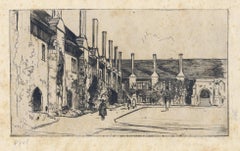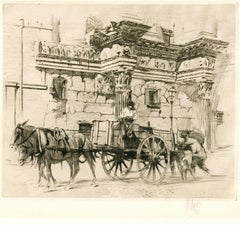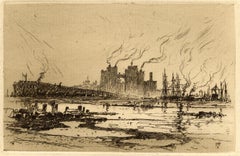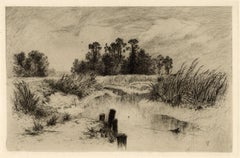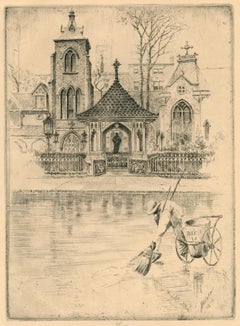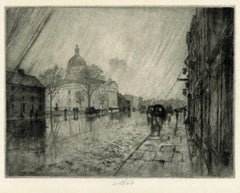Rob Zanger Rare Books LLC Landscape Prints
to
244
10
2
Overall Width
to
Overall Height
to
94
25
1
52
8
5
3
3
46
85
125
2
10
7
3
24
140
116
164
98
92
48
45
41
38
38
28
27
26
24
20
19
18
17
15
13
13
12
226
179
157
96
95
4
256
Almshouses, St. Cross
By Sir David Young Cameron, R.A.
Located in Middletown, NY
Glasgow: Walton's Compleat Angler, 1902. Etching on heavy Japan paper, 3 7/16 x 5 15/16 inches (80 x 149 mm), full margins. Initialed in pencil, lower ...
Category
Early 1900s Modern Landscape Prints
Materials
Etching
Forum of Minerva, Assisi, Italy
By William Walcot R. E. Hon. R. I. B. A.
Located in Middletown, NY
Etching with aquatint on watermarked F J Head & Co. cream laid paper, 9 3/4 x 11 1/2 inches (245 x 290 mm), full margins. Signed in pencil, lower margin. Scattered age tone and mat t...
Category
Early 20th Century Modern Landscape Prints
Materials
Laid Paper, Etching, Aquatint
Communipaw, NY; January Thaw
By Thomas Moran
Located in Middletown, NY
A delicate composition of an industrial Hudson River town, seen from lower Manhattan; a view of what is now Liberty State Park.
New York: 1884. Etching with aquatint on cream laid p...
Category
Late 19th Century Realist Landscape Prints
Materials
Laid Paper, Etching, Aquatint
Passaic Meadows (In the Newark Meadows)
By Thomas Moran
Located in Middletown, NY
Boston: American Art Review, 1880. Etching on cream laid paper, 5 3/4 x 8 3/4 inches (146 x 230mm), full margins. Light uniform age tone, scattered handling creases and minor toning ...
Category
Late 19th Century Realist Landscape Prints
Materials
Laid Paper, Etching
The Lych Gate; Little Church Around the Corner - New York
Located in Middletown, NY
Etching and sand ground on cream laid paper, 10 1/2 x 7 5/8 inches (262 x 193 mm), full margins. Inscribed "No. 29" in black ink, lower right margin. In good condition with minor tim...
Category
Early 20th Century American Modern Landscape Prints
Materials
Etching, Laid Paper
Rainy Day, Providence
Located in Middletown, NY
Etching with drypoint on Japan paper, 9 3/4 x 12 3/4 inches (245 x 322 mm), full margins, from an edition of approximately 50. Signed by the artist in pencil, lower center margin, t...
Category
Early 20th Century American Modern Landscape Prints
Materials
Handmade Paper, Drypoint, Etching
Les Belles et la Bête: Before the Hunt
By Peter Milton
Located in Middletown, NY
Resist ground etching and engraving on cream wove paper, 22 x 39 inches (558 x 990 mm), full margins. Signed, titled, dated, and numbered 27/160 in pencil, lower margin. With the blindstamp of the printer, Robert E. Townsend, in the lower left margin. A beautiful, richly inked impression of this highly detailed, large image. In very good condition with minor mat tone, extremely minor scattered light surface soiling, and one pin-point sized dot of brown discoloration on the lower left margin, recto, well outside of image area.
[Milton 99].
Milton states that there is a metaphorical evolution at the root of his body of graphic work, and with Les Belles et la Bête, Before the Hunt, he found himself at a crossroads that he viewed as a sort of artistic adolescence, which he felt demanded a natural examination of mysteries of sexual awakening. The image is brimming with fantastical images and metaphors for the confrontation of sexual exploration; a Freudian analyst appears in the left of the image, scattered tableaus of paired figures...
Category
1970s American Modern Interior Prints
Materials
Engraving, Archival Paper, Etching
Les Belles et La Bête I: The Rehearsal
By Peter Milton
Located in Middletown, NY
Resist ground etching and engraving on Rives heavyweight buff paper, 20 x 36 inches (508 x 914 mm), full margins. Signed, titled, dated and numbered 103/160 in pencil, lower margin. Minor mat tone. A rich and finely printed impression of this complex and iconic work by Milton. Framed handsomely under Plexiglas with archival materials in a solid wood frame with silver finish.
[Milton 98].
Milton states that in the evolution of his body of graphic work he found himself at point that necessitated the exertion of nerve in his subject matter. He found it imperative for growth to explore whether his compositions had previously been too polite, and through this process he experienced a great burst of artistic and psychic liberation. Milton refers to this awakening as a sort of adolescence, which he felt demanded a natural examination of mysteries of sexual awakening. Les Belles et La Bête...
Category
1970s American Modern Interior Prints
Materials
Engraving, Archival Paper, Etching
Mornings with Judd (Second state)
By Peter Milton
Located in Middletown, NY
Lift ground and hard ground etching and engraving on Murillo white wove paper, 18 x 24 inches (455 x 608 mm), full margins. Signed, dated, titled and numbered 60/100 in pencil, lower margin. Printed and published by the artist. In very good condition with minor age tone and scattered light surface soiling on the verso. Framed handsomely in an original Kulicke welded aluminum frame with the embossed maker's mark. [Milton 61].
Milton revisited this image in 1974 during an experiment to explore collage and the process of contact printing a high resolution photo-transparency directly onto a copper plate. He printed a small detail transparency of Mornings with Judd onto the existing plate, alongside it's larger self, and broke through to a new photo-resist approach, which Milton described as "piquant and irresistible," in his essays appearing in Robert Flynn...
Category
1970s American Modern Landscape Prints
Materials
Engraving, Etching, Archival Paper
New York Skyline, NY; East River
By Leon Dolice
Located in Middletown, NY
Etching on medium stock, cream wove paper, 5 15/16 x 10 3/16 inches (151 x 259 mm), full margins. Signed and titled in pencil, lower margin. A fine and detailed impression in dark bl...
Category
1930s American Modern Landscape Prints
Materials
Archival Paper, Etching
Arcadian riverscape with different figures by a tree [Arcadisch rivierlandschap]
Located in Middletown, NY
A beautiful Arcadian landscape after Johannes Glauber.
Amsterdam: 1721.
Etching on handmade laid paper with an intact fleur-de-lis watermark. 203 x 275 mm; 8 x 10 7/8 inches, trimm...
Category
18th Century Old Masters Landscape Prints
Materials
Handmade Paper, Laid Paper, Etching
On the Hard
Located in Middletown, NY
An elegant and delicate seascape of Brightlingsea Hard, Essex
circa 1925
18/75. Drypoint etching on cream laid paper, 5 1/2 x 7 7/8 inches (138 x 198 mm), full margins. Signed and ...
Category
1920s Realist Landscape Prints
Materials
Drypoint, Laid Paper
Campagne boisée (Wooded countryside)
By Jean-Baptiste-Camille Corot
Located in Middletown, NY
1866
Etching on cream wove paper. 5 1/2 x 4 3/8 inches (138 x 110 mm), full margins. Third state (of 4). Light scattered age tone, and time stain. Scattered extremely light areas of ...
Category
Mid-19th Century Barbizon School Landscape Prints
Materials
Etching
Cat and Busybody
By Benton Murdoch Spruance
Located in Middletown, NY
A 1933 lithograph on cream wove paper 14 x 18 inches (354 x 452mm), full margins. Signed, titled, and numbered 17/33 in pencil, lower margin. Minor mat tone around the perimeter of t...
Category
1930s American Modern Landscape Prints
Materials
Lithograph
Palazzo dell'Angelo
By John Taylor Arms
Located in Middletown, NY
Palazzo dell'Angelo
1931
Etching and drypoint on cream-colored, handmade laid paper with deckle edges, 7 1/4 x 6 3/4 inches (185 x 171 mm), edition of 100, full margins. Signed, dated and numbered "Ed. 100" in pencil, lower margin, second state (of three). Printed by Henry Carling, New York. Extremely minor mat tone and some inky residue in the top right corner, all unobtrusive and well outside of image area. An exquisite impression of this intricate image, with astonishing detail, and all the fine lines printing clearly. The image represents the first print which Arms printed on his own handmade paper. Framed handsomely with archival materials and museum grade glass in a wood gilt frame with a flower and garland motif.
Illustrated: Dorothy Noyes Arms, Hill Towns and Cities of Northern Italy, p. 180; Anderson, American Etchers Abroad 1880-1930; Eric Denker, Reflections & Undercurrents: Ernest Roth and Printmaking in Venice, 1900-1940, p. 116.
[Fletcher 233]
Born in 1887 in Washington DC, John Taylor Arms studied at Princeton University, and ultimately earned a degree in architecture at the Massachusetts Institute of Technology in 1912. With the outbreak of W.W.I, Arms served as an officer in the United States Navy, and it was during this time that he turned his focus to printmaking, having published his first etching in 1919. His first subjects were the Brooklyn Bridge, near the Navy Yard, and it was during his wartime travel that Arms created a series of extraordinarily detailed etchings based on Gothic cathedrals and churches he visited in France and Italy. He used what was available to him, namely sewing needles and a magnifying glass, to create the incredibly rich and fine detail that his etchings are known for. Upon his return to New York after the war, Arms enjoyed a successful career as a graphic artist, created a series of etchings of American cities, and published Handbook of Print Making and Print Makers (Macmillan, 1934). He served as President of the Society of American Graphic Artists, and in 1933, was made a full member of the National Academy of Design.
In its most modern incarnation, Palazzo dell'Angelo was constructed in or around 1570. The building, which has a rich and storied history, was erected upon the ruins of an earlier structure which predates the Gothic period. Some remnants of the earliest features of the residence were most certainly still visible when Arms visited, as they are today. Having a background in architecture, there's no question that Arms was moved by the beauty, history and ingenuity represented in the physical structure. One thing specifically gives away Arms's passion for the architecture, and that is the fact that he focused on the building's Moorish entranceway, balustrade, and two mullioned windows, and not on the curious Gothic era bas-relief of an angel nestled into the facade of the building, after which the structure is named. The sculpture itself doesn't appear in Arms's composition at all, despite the fact that it is the feature of the building that is most famous in its folklore. Arms instead focuses on the oldest portion of the architecture, even documenting some of the remnants of a fresco, and a funerary stele for the freedman Tito Mestrio Logismo, and his wife Mestria Sperata (visible above the water level, to the left of the door, behind the gondola), which was first described in 1436.
Among the many notable bits of history regarding the Palazzo, it has been documented that Tintoretto painted frescos of battle scenes on the facade of the building. The paintings have been lost to time and the elements, but not entirely to history. The empty frame...
Category
1930s American Modern Figurative Prints
Materials
Etching, Drypoint
Guardians of the Spire; Amiens Cathedral Number 2
By John Taylor Arms
Located in Middletown, NY
Guardians of the Spire; Amiens Cathedral Number 2
New York: 1937. Etching and drypoint on watermarked F.J. Head cream-colored, antique laid paper, 6 3/4 ...
Category
Mid-20th Century American Modern Figurative Prints
Materials
Drypoint, Etching
